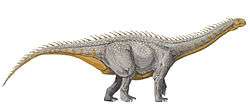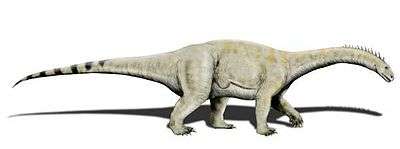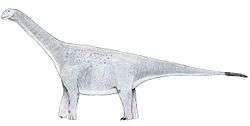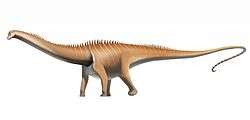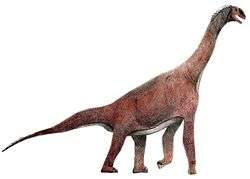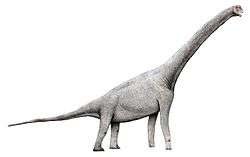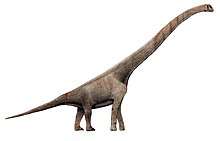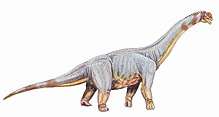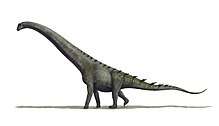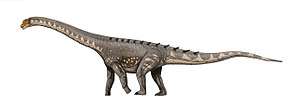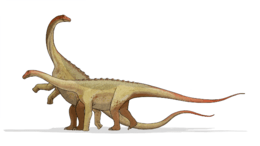Argentinosaurus
| Argentinosaurus | |
|---|---|
 | |
| Reconstructed skeleton, Museo Municipal Carmen Funes, Plaza Huincul, Argentina | |
| Scientific classification | |
| Kingdom: | Animalia |
| Phylum: | Chordata |
| Clade: | Dinosauria |
| Order: | Saurischia |
| Suborder: | †Sauropodomorpha |
| Clade: | †Sauropoda |
| Clade: | †Titanosauria |
| Clade: | †Lognkosauria |
| Genus: | †Argentinosaurus Bonaparte & Coria, 1993 |
| Type species | |
| Argentinosaurus huinculensis | |
Argentinosaurus (meaning "Argentine lizard"[1]) is a genus of titanosaur sauropod dinosaur first discovered by Guillermo Heredia in Argentina. The generic name refers to the country in which it was discovered. The dinosaur lived on the then-island continent of South America somewhere between 97 and 93.5 million years ago,[2] during the Late Cretaceous Period. It is among the largest known dinosaurs.
Description

Not much of Argentinosaurus has been recovered. The holotype included only a series of vertebrae (six from the back, five partial vertebrae from the hip region), ribs of the right side of the hip region, a part of a rib from the flank, and the right fibula (lower leg bone). One of these vertebrae was 1.59 meters tall, and the fibula was about 1.55 meters (61 inches).[3] In addition to these bones, an incomplete femur (upper leg bone, specimen number MLP-DP 46-VIII-21-3) is assigned to Argentinosaurus; this incomplete femur shaft has a minimum circumference of about 1.18 meters.[4] The proportions of these bones and comparisons with other sauropod relatives allow paleontologists to estimate the size of the animal.
Size

An early reconstruction by Gregory S. Paul estimated Argentinosaurus at between 30–35 metres (98–115 ft) in length and with a weight of up to 80–100 tonnes (88–110 short tons).[5][6] The length of the skeletal restoration mounted in Museo Carmen Funes is 39.7 metres (130 ft) long and 7.3 metres (24 ft) tall at the shoulder. This is the longest reconstruction in a museum and contains the original material, including a mostly complete fibula.[7] Other estimates have compared the fragmentary material to relatively complete titanosaurs to help estimate the size of Argentinosaurus. In 2006 Carpenter used the more complete Saltasaurus as a guide and estimated Argentinosaurus at 30 metres (98 ft) in length.[8] An unpublished estimate used published reconstructions of Saltasaurus, Opisthocoelicaudia, and Rapetosaurus as guides and gave shorter length estimates of between 22–26 metres (72–85 ft).[9] Weight estimates are less common, but Mazzetta et al. (2004) provide a range of 60–88 tonnes (66–97 short tons), and consider 73 tonnes (80 short tons) to be the most likely, making it the heaviest sauropod known from good material.[4] More recently, it was estimated at 83.2 tonnes (91.7 short tons) by calculating the volume of the aforementioned Museo Carmen Funes skeleton.[7] Scott Hartman suggests that since Argentinosaurus is a basal titanosaur, it would have a shorter tail and narrower chest than Puertasaurus, suggesting that it was slightly smaller than other giant titanosaurs such as Puertasaurus and Alamosaurus.[10]
Discovery
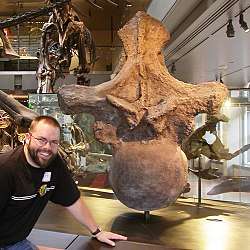
The first fossils identified as Argentinosaurus were found in 1987 by a rancher in Argentina, who mistook the leg for a giant piece of petrified wood. A gigantic vertebra, approximately the size of a man, was also found.[1]
The type and only species, A. huinculensis, was described and published in 1993 by the Argentine palaeontologists José F. Bonaparte and Rodolfo Coria. Its more specific time-frame within the Cretaceous is the late Cenomanian faunal stage, ~96 to 94 million years ago. The fossil discovery site is in the Huincul Formation of the Río Limay Subgroup in Neuquén Province, Argentina (the Huincul Formation was a member of the Río Limay Formation according to the naming of the time).[3]
Paleobiology
Biomechanics and speed
In 2013, in a study published in PLoS ONE on October 30, 2013 by Dr. Bill Sellers, Dr. Rodolfo Coria, Lee Margetts et al., Argentinosaurus was digitally reconstructed to test its locomotion for the first time. Before this study, the most common way of estimating speed was through studying bone histology and ichnology. Commonly, studies about sauropod bone histology and speed focus on the postcranial skeleton which holds many unique features, such as an enlarged process on the ulna, a wide lobe on the ilia, an inward-slanting top third of the femur, and an extremely ovoid femur shaft. Those features are useful when attempting to explain trackway patterns of graviportal animals. When studying ichnology to calculate sauropod speed, there are a few problems, such as only providing estimates for certain gaits because of preservation bias, and being subject to many more accuracy problems.[7]
To estimate the gait and speed of Argentinosaurus, the study performed a musculoskeletal analysis. The only previous musculoskeletal analyses were conducted on hominids, terror birds, and other dinosaurs. Before they could conduct the analysis, the team had to create a digital skeleton of the animal in question, show where there would be muscle layering, locate the muscles and joints, and finally find the muscle properties before finding the gait and speed. The results of the biomechanical study revealed that Argentinosaurus was mechanically competent at a top speed of 2 m/s (5 mph) given the great weight of the animal and the strain that its joints were capable of bearing. The results further revealed that much larger terrestrial vertebrates might be possible, but would require significant body remodeling and possibly behavioral change to prevent joint collapse.[7][11]
Digestion
.jpg)
Argentinosaurus was, like all sauropods, a herbivore. It probably used its long neck to reach into conifers, or sweep the ground in search of ferns and bushes. Once inside the stomach, the vegetation would have been ground or broken down by smooth stones known as gastroliths.[1]
Growth
Studies show that Argentinosaurus did not stop growing in its lifetime. One article found that Argentinosaurus hatchlings would have had to grow 25,000 times their original size before reaching adult size. Argentinosaurus probably traveled in herds of a few dozen animals, including juveniles. Young animals were vulnerable to attacks from predators. It is thought that only a handful of juveniles would be lucky enough to reach adulthood. Fossilized eggs of sauropods related to Argentinosaurus have been preserved. These eggs show that every year, hundreds of adults would gather to nest. Wide flat floodplains have been identified as the preferred nesting sites. The eggs were around 22 centimetres (8.7 in) in diameter, and each adult probably laid large numbers of eggs each season. Once hatched, it took about 15 years for the tiny hatchlings to reach adulthood, and gigantic size.[1]
References
- 1 2 3 4 Haines, T.; Chambers, P. (2007). The Complete Guide to Prehistoric Life. Italy: Firefly Books Ltd. pp. 118–119. ISBN 1-55407-181-X.
- ↑ Holtz, Thomas R. Jr. (2012) Dinosaurs: The Most Complete, Up-to-Date Encyclopedia for Dinosaur Lovers of All Ages, Winter 2011 Appendix.
- 1 2 Bonaparte J, Coria R (1993). "Un nuevo y gigantesco sauropodo titanosaurio de la Formacion Rio Limay (Albiano-Cenomaniano) de la Provincia del Neuquen, Argentina". Ameghiniana (in Spanish). 30 (3): 271–282.
- 1 2 Mazzetta, Gerardo V.; Christiansen, Per; Fariña, Richard A. (2004). "Giants and Bizarres: Body Size of Some Southern South American Cretaceous Dinosaurs" (PDF). Historical Biology. 16 (2–4): 71–83. doi:10.1080/08912960410001715132. Retrieved 2008-01-08.
- ↑ Paul, Gregory S. (Autumn 1994). "Big Sauropods - Really, Really Big Sauropods" (PDF). The Dinosaur Report. The Dinosaur Society: 12–13. Retrieved 2011-11-14.
- ↑ Paul, Gregory S. (1997). "Dinosaur models: the good, the bad, and using them to estimate the mass of dinosaurs". In Wolberg, D. L.; Stump, E.; Rosenberg, G. D. DinoFest International Proceedings. The Academy of Natural Sciences. pp. 129–154.
- 1 2 3 4 Sellers, W. I.; Margetts, L.; Coria, R. A. B.; Manning, P. L. (2013). Carrier, David, ed. "March of the Titans: The Locomotor Capabilities of Sauropod Dinosaurs". PLoS ONE. 8 (10): e78733. doi:10.1371/journal.pone.0078733. PMC 3864407. PMID 24348896.
- ↑ Carpenter, Kenneth (2006). "Biggest of the Big: A Critical Re-Evaluation of the Mega-Sauropod Amphicoelias fragillimus Cope, 1878" (PDF). In Foster, John R.; Lucas, Spencer G. Paleontology and Geology of the Upper Jurassic Morrison Formation. 36. New Mexico Museum of Natural History and Science Bulletin. pp. 131–138.
- ↑ Mortimer, Mickey (2001-09-12). "Titanosaurs too Large?". Dinosaur Mailing List. Retrieved 2009-01-08.
- ↑ http://www.skeletaldrawing.com/home/2013/06/the-biggest-of-big.html?rq=puertasaurus
- ↑ "Argentinosaurus"
External links
- Brief introduction and an idea of the scale of a vertebra
- Another brief introduction, with the restoration at Fernbank Museum, Atlanta, Georgia
- Argentinosaurus vs. Mapusaurus
- Argentinosaurus data sheet German with picture

